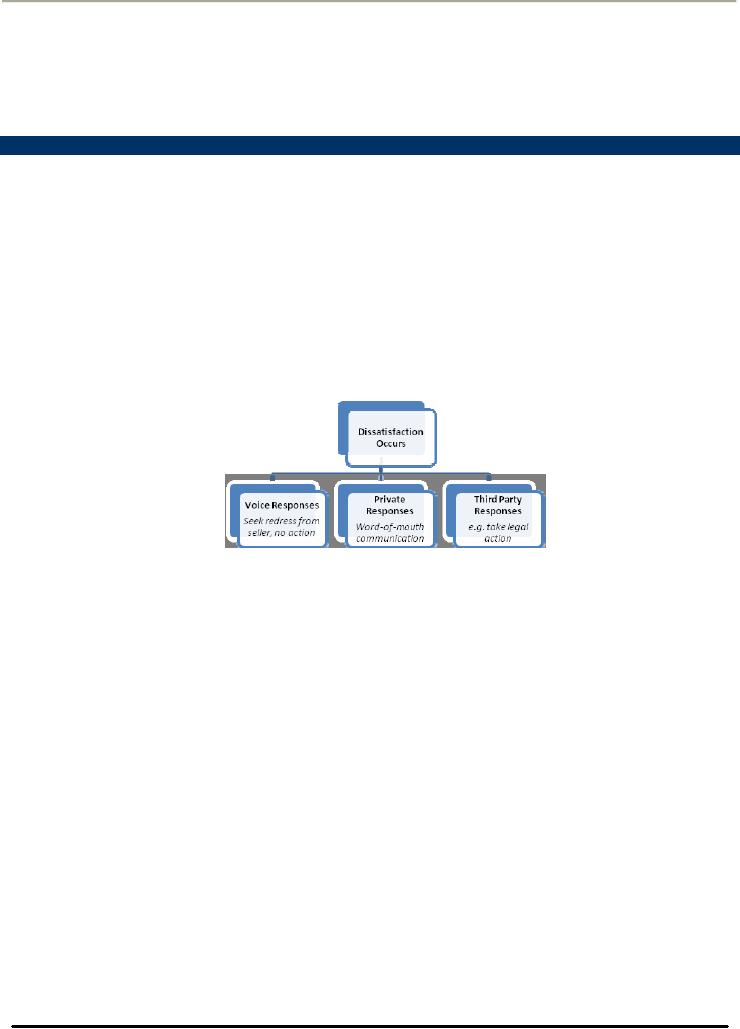 |

Consumer
Psychology (PSY -
514)
VU
Lecture
41
Post
Purchase Evaluation
Understanding:
Post
Purchase Evaluation
Consumer
Complaint Behavior
1.
Post Purchase Evaluation
Consumer
is uncertain of the wisdom of his
decision; he rethinks this decision in the post
purchase stage
Post
purchase stage serves to broaden the
consumer's set of experiences
stored in the memory. It provides a
check
on
how well he is doing as a
consumer in selecting products,
stores, etc... Feedback that
consumer receives
from
this
stage helps make adjustments
in future purchasing
strategies.
Satisfaction
is an important element in the evaluation
stage. Satisfaction refers to the
buyer's state of being
adequately
rewarded in buying situations
for the sacrifice he has
made.
Adequacy
of
satisfaction is a result of matching
actual post purchase and
consumption experience with the
expected
reward from the brand in terms of
its anticipated potential to satisfy the
consumer's motives
Hunt's
definition: Satisfaction
is a kind of stepping away
from an experience and evaluating it ...
One could have
a
pleasurable experience that
caused dissatisfaction because
even though pleasurable, it
wasn't as pleasurable as it
was
supposed or expected to be. So
satisfaction/dissatisfaction is not an emotion, it is
the evaluation of an
emotion
Consumers'
Expectations Prior to Purchase
Consumers
form certain expectations
prior to purchase. These include: the
nature and performance
of
product/service
(the anticipated benefits to be derived directly from
the item). The costs and
efforts to be
expended
before obtaining the direct product or
service benefits and social benefits or
costs accruing to the
consumers
as a result of purchase (the anticipated
impact of the purchase on significant
others).
Determinants
of Satisfaction
Growing
body of research suggests
that there are several
determinants which appear to influence
satisfaction
including:
�
Demographic
Variables
�
Personality
Variables
�
Expectations
Some
other important variables
are:
Men
tend to be more satisfied than
women
The
more confidence one has in
purchase decision making and
more competence in a given product
area, the
greater
one's satisfaction tends to
be
Older
consumers tend to have lower
expectations and higher level of
satisfaction
Higher
education tends to be associated
with lower
satisfaction
There
is also greater satisfaction when
relevant others are perceived to be
more satisfied
Higher
levels of product satisfaction
are also indicated by persons
who are more satisfied
with their lives as a
whole
and by persons who are
more satisfied with consumer
domain that is market place,
consumerism and
business
firms
Relationship
between Expectations and
Performance
The
interaction between expectations
and actual product
performance produces either satisfaction
or
dissatisfaction.
There, however, does not
appear merely to be a direct relationship
between the level of expectation
and
level of satisfaction instead a modifying
variables is more important
here.
131

Consumer
Psychology (PSY -
514)
VU
Disconfirmation
of Satisfaction
When
a consumer does not get what
is expected the situation can be
described as disconfirmation. Positive
Disconfirmation
occurs
when what is perceived is better than what is
expected. Negative
Disconfirmation
occurs
when things turn out worse
than expected.
Confirmation
occurs if the expectations from a
product are met
2.
Consumer Complaint
Behavior
Consumers
may exhibit unfavorable word-of-mouth
communication, if they are dissatisfied
with a product. In this
case,
customers tell twice as many
people about bad experiences as
good ones and such
behavior can severely
damage
a company's image. Consumers
may not repurchase the
brand.
Third
action several generalizations exist
from research on consumer
complaining:
Complainers
tend to be of more upscale
socio-economic groups than
non-complainers
The
severity of the dissatisfaction or
problems is positively related to
complaint behavior
Complaining
is more likely when there is
more positive perception of retailer
responsiveness to customer
complaints
Model
of Consumer Complaining
Behavior
Consumers
may complain not to seller
but a third party such as
news papers or legal system.
They may engage in
private
CCB e.g. telling friends and
relatives about their bad
experience and changing
their patronage. They
may
complain
their voices to manufacturer or retailer
involved or even take no action if they
are loyal to seller
and
believe
that complaining is pointless
132
Table of Contents:
- INTRODUCTION TO CONSUMER PSYCHOLOGY:Consumer Behavior
- INTRODUCTION TO CONSUMER PSYCHOLOGY:Consumer research
- INTRODUCTION TO CONSUMER PSYCHOLOGY:Marketing Mix, Product, Price
- INTRODUCTION TO CONSUMER PSYCHOLOGY:Customer Value, Perceived Value
- VALUE AND RETENTION FOCUSED MARKETING AND CONSUMER DECISION MAKING PROCESS
- CONSUMER RESEARCH:Quantitative Research, Qualitative Research
- MAJOR STEPS IN CONSUMER RESEARCH PROCESS:Design of Primary research
- QUANTITATIVE RESEARCH DESIGNS & DATA COLLECTION METHODS
- QUANTITATIVE RESEARCH DATA COLLECTION TECHNIQUES:ATTITUDE SCALES
- QUALITATIVE RESEARCH DESIGNS & DATA COLLECTION METHODS
- CUSTOMER SATISFACTION MEASUREMENT, SAMPLING, AND DATA ANALYSIS AND REPORTING
- MARKET SEGMENTATION AND ITS BASES:Geographical Segmentation
- BASES FOR SEGMENTATION: DEMOGRAPHIC SEGMENTATION PSYCHOGRAPHIC SEGMENTATION
- BASES FOR SEGMENTATION: SOCIOCULTURAL SEGMENTATION USE RELATED SEGMENTATION USAGE SITUATION SEGMENTATION
- BASES FOR SEGMENTATION: BENEFIT SEGMENTATION:Intrinsic Cues
- BASES FOR SEGMENTATION: HYBRID SEGMENTATION STRATEGIES
- MARKET SEGMENTATION IMPLEMENTING SEGMENTATION STRATEGIES ENVIRONMENTAL INFLUENCES CULTURE
- HOW CULTURE IS LEARNT ENVIRONMENTAL INFLUENCES:Formal Learning
- CULTURE AND ITS MEASUREMENT ENVIRONMENTAL INFLUENCES
- MEASUREMENT OF CULTURE ENVIRONMENTAL INFLUENCES:Consumer Fieldwork
- SUBCULTURE CHAPTER 4: ENVIRONMENTAL INFLUENCES
- AGE AND GENDER SUBCULTURE CHAPTER 4: ENVIRONMENTAL INFLUENCES
- BASES FOR SEGMENTATION: BENEFIT SEGMENTATION:Market Segmentation
- SOCIAL CLASS CHAPTER 4: ENVIRONMENTAL INFLUENCES:Occupation
- CONSUMER SOCIAL CLASSES CHAPTER 4: ENVIRONMENTAL INFLUENCES:Affluent Consumer
- CONSUMER SOCIAL CLASSES CHAPTER 4: ENVIRONMENTAL INFLUENCES:Membership Group
- CONSUMER SOCIAL CLASSES CHAPTER 4: ENVIRONMENTAL INFLUENCES:Shopping Groups
- UNDERSTANDING PERSONALITY CHAPTER 5: INDIVIDUAL DETERMINANTS OF CONSUMER BEHAVIOR
- CONSUMER PERSONALITY, TRAIT THEORY AND SELF IMAGES
- CONSUMER MOTIVATION:Needs, Goals, Generic Goals
- UNDERSTANDING LEARNING:Intentional and Incidental Learning, Implications for Marketers
- INSTRUMENTAL CONDITIONING, INFORMATION PROCESSING AND MEMORY
- ATTITUDES:Characteristics of Attitudes, Attitudes have consistency
- ATTITUDE FORMATION AND CHANGE:How attitudes are learned?
- ATTITUDE CHANGE STRATEGIES:Resolving two conflicting attitudes
- INTRODUCTION TO CONSUMER DECISION MAKING:Decision Complexity
- Problem Recognition, Search and Evaluation and Decision and Purchase
- Decision and Purchase:Consumer Decision Rules, Output, Relationship Marketing
- Decisions Related to Post Purchase:Product Set up and Use
- Marketing Implications of Decisions Related to Post Purchase:Understanding
- Post Purchase Evaluation:Determinants of Satisfaction, Consumer Complaint Behavior
- Post Purchase Dissonance:Dissonance Reduction, Marketing Implications
- Consumerism:Roots of Consumerism, The Nature of Consumerism
- Consumerism – Issues and Responses:Environmental Concerns, Consumer Privacy
- Review – Consumer Psychology Course:Consumer Research, Consumerism